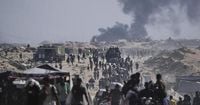On Sunday, August 24, 2025, the humanitarian crisis gripping Gaza reached a tragic new chapter when Israeli forces shot dead four Palestinian aid-seekers as they traveled through a military zone south of Gaza City. The area, regularly used by desperate residents to reach food distribution points and a hospital, became the latest flashpoint in a war that has now raged for nearly two years. Witnesses and medical sources, including Al-Awda Hospital, told The Associated Press that Israeli troops opened fire on a crowd heading toward a site operated by the U.S.-backed Gaza Humanitarian Foundation in the Netzarim corridor. The shooting occurred hundreds of meters from the aid site, which has become a lifeline for thousands facing famine.
“The gunfire was indiscriminate,” said Mohamed Abed, a father of two from the Bureij refugee camp, in comments reported by AP. Abed and fellow aid-seeker Aymed Sayyad described a chaotic scene: as a group at the front of the crowd surged toward the distribution site before its scheduled opening, Israeli troops opened fire. Sayyad said he and others rushed to help two people wounded by gunshots. The Gaza Humanitarian Foundation, however, disputed the account in an email, saying, “This incident didn’t occur near our site nor as described.” The Israeli military did not immediately respond to requests for comment.
Gaza City is now in the grip of famine, a consequence of 22 months of war and tightening restrictions on food and medical supplies. According to Gaza’s Health Ministry, eight more malnutrition-related deaths were reported on Sunday, including a child, bringing the total number of such deaths during the conflict to 289—115 of them children. The ministry, part of the Hamas-run government and staffed by medical professionals, reported that at least 62,686 Palestinians have been killed since the war began, including those missing but confirmed dead. The U.N. and independent experts continue to regard the Health Ministry as the most reliable source for war casualties, though Israel disputes its figures and has not provided alternatives.
The scale of suffering is staggering. More than 2,000 Palestinians have been killed and over 13,500 wounded while seeking aid at distribution points or along convoy routes used by the United Nations and other humanitarian groups, according to the Health Ministry. About half of the dead are reported to be women and children. On Sunday, thousands of Palestinians once again risked their lives, trekking across dangerous terrain for the chance to secure a sack of flour or other basic food staples for their families.
The world’s leading authority on food crises, the Integrated Food Security Phase Classification, announced on Friday that famine is already occurring in Gaza City and could spread further south to Deir al-Balah and Khan Younis by the end of September. Aid groups have long warned that the war, combined with months of Israeli restrictions, is causing starvation. Israel, for its part, has consistently denied the existence of widespread hunger in Gaza, dismissing reports of starvation as “lies” promoted by Hamas.
Meanwhile, the Israeli military is preparing for a major offensive to seize Gaza City, a move that could come within days. Defense Minister Yoav Gallant has warned that the city—still home to hundreds of thousands—could face destruction. In the densely populated Jabaliya refugee camp north of the city, residents described enduring “non-stop explosions and strikes” in recent days. Ossama Matter, a displaced Palestinian, told AP that neighborhoods had been razed beyond recognition: “They want it like Rafah,” he said, referencing the southern Gaza city devastated earlier in the war.
Another resident, teacher Salim Dhaher, recounted seeing robots planting explosives as Israeli troops advanced. He voiced a widespread fear among Palestinians that the destruction is part of a larger effort to forcibly remove them from the north. “The aim is clear: to destroy everything above the ground and force the transfer,” Dhaher said.
Despite the looming offensive, there was little sign of mass evacuation from Gaza City. Many residents, exhausted by repeated displacements, are unconvinced that any area—including so-called humanitarian zones—offers real safety. The war’s origins trace back to October 7, 2023, when Hamas-led militants abducted 251 people and killed about 1,200, mostly civilians, in a shock attack that triggered Israel’s ongoing military campaign. While most hostages have since been released through ceasefires or other deals, about 50 remain in Gaza, with around 20 believed to be alive. Their families fear that a new Israeli offensive will put their loved ones in even greater danger, and calls for a hostage deal have grown louder, with protesters gathering outside the homes of key government officials.
The violence is not confined to Gaza. On the same day as the deadly shooting of aid-seekers, the Israeli military struck several targets in Sanaa, Yemen’s Houthi-controlled capital. The IDF said it targeted a military compound housing the presidential palace, power stations, and a fuel storage site in retaliation for repeated missile and drone attacks by the Houthi regime against Israel. The Houthi Health Ministry reported that the number of people killed in the Israeli attack had risen to six, with 86 wounded. Civil defense and rescue teams continued to search for victims and extinguish fires caused by what the ministry called “the Zionist aggression.”
Elsewhere, tensions flared in Israel itself. The Shin Bet security service and police announced the arrest of two Palestinians in Tel Aviv after an alert suggested they intended to carry out a terrorist attack. Four additional Palestinians were arrested for lacking permits, though they were not linked to the suspects. Meanwhile, five Israeli settlers were also detained on suspicion of violent activity against security forces, according to a joint statement by Shin Bet and police. A gag order was issued for the case.
In the West Bank and beyond, violence and political turmoil continue to ripple outward. The Hamas-run Gaza Health Ministry reported 64 people killed and 278 wounded by Israeli fire in the Gaza Strip in the 24 hours prior to August 24. A former IDF major general was investigated and released on suspicion of bribery and breach of trust, highlighting corruption concerns at the highest levels.
Diplomatic efforts to end the conflict remain stalled. Hamas announced on Sunday that it had accepted a new ceasefire proposal from Arab mediators, stating, “We agreed to a partial deal, while we also expressed readiness for a comprehensive one, HOWEVER, (Israeli Prime Minister Benjamin) Netanyahu rejects all solutions.” The Israeli government has yet to respond positively, and many observers believe that any breakthrough will have to wait until after the next phase of military operations.
As the war grinds on, the suffering of civilians—whether in Gaza, Israel, or neighboring countries—shows little sign of abating. Each day brings new tragedies, new political complications, and ever more urgent calls for a resolution that remains stubbornly out of reach.






